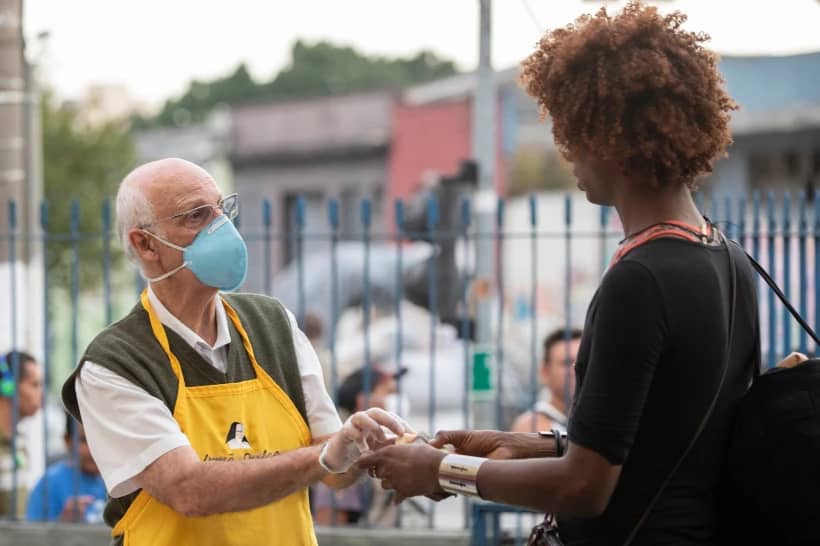Amidst the silence and numbness of his disciples, both then and now, Pope Francis insisted on Saturday during an Easter Vigil Mass, Christ has risen, and this is the message that sustains hope, turning it into concrete gestures of charity.
“How greatly we need to let our frailty be anointed by this experience!” Francis said during the homily he delivered in what the Church’s collection of prayers for the Mass describes as the “mother of all vigils.”
“How greatly we need to let our faith be revived! How greatly we need our myopic horizons to be challenged and renewed by this message! Christ is risen, and with him he makes our hope and creativity rise, so that we can face our present problems in the knowledge that we are not alone,” the pope said to a packed St. Peter’s Basilica on a stormy Roman night.
The Roman Missal, which spells out specifics of how the vigil is to be celebrated, says that this liturgy is the “greatest and most noble of all solemnities and it is to be unique in every single church.”
The description found in the missal, “mother of all vigils,” comes from St. Augustine’s Sermon 209.
To celebrate Easter, Francis said in his homily, “is to believe once more that God constantly breaks into our personal histories, challenging our ‘conventions,’ those fixed ways of thinking and acting that end up paralyzing us.”
“To celebrate Easter is to allow Jesus to triumph over the craven fear that so often assails us and tries to bury every kind of hope,” he continued.
Before the injustice that condemned Jesus, Francis said, his disciples were silent, numb and paralyzed, not knowing what to do “amid so many painful and disheartening situations.”
Later in his homily, he said that today too, those who follow Jesus often remain speechless in the “face of situations we cannot control, that make us feel and, even worse, believe that nothing can be done to reverse all the injustices that our brothers and sisters are experiencing in their flesh.”
Throughout his remarks, Francis often alternated between the third and the second person, drawing a parallel between those depicted in the Gospel as followers of Christ with those who today too follow- and hide, escape, keep silent- before the “calumnies and the false testimony that the Master endured.”
On Holy Friday, day of the Passion and Crucifixion of Christ, “we joined the women in contemplating ‘the one who was pierced’,” Francis said. “Today, with them, we are invited to contemplate the empty tomb and to hear the words of the angel: ‘Do not be afraid… for he has been raised.’”
Those words, the pontiff said on Saturday, should affect our convictions and certainties, and the way we deal with the events of our day-to-day, especially in the way we treat others.
“The empty tomb should challenge us and rally our spirits,” he said. “It should make us think, but above all it should encourage us to trust and believe that God ‘happens’ in every situation and every person, and that his light can shine in the least expected and most hidden corners of our lives.”
Holy Saturday, Francis said, is the silent night of those who follow Christ, who are “disoriented,” because they’re “plunged in a crushing routine that robs memory, silences hope and leads to thinking that ‘this is the way things have always been done’.”
Yet his resurrection, witnessed first by the stone that blocked Christ’s tomb and then by the women who first saw him when he rose from the death, is an invitation, “addressed once more to you and to me,” the pope said.
“Do we want to share in this message of life or do we prefer simply to continue standing speechless before events as they happen?” Francis said, towards the end of his homily.

Throughout Holy Week, that began on Palm Sunday, Francis had a gloomy and somber face, even as he led the Good Friday service in St. Peter’s Basilica and the Way of the Cross in Rome’s Colosseum later that day.
Nevertheless, Saturday’s vigil was one of hope, reaching a climax with the ringing of the basilica’s bells and the singing of the “Gloria” and the “Alleluia” to celebrate Christ’s resurrection from the dead.
As in Latin-rite parishes throughout the world, the ceremony in the papal basilica began with the lights dimmed to a minimum, and Francis processed into a silent church carrying a lone candle, which he used to light the candles of those nearby, who, in turn, shared the flame with those around themselves, eventually lighting thousands of candles provided by the Vatican for the occasion.
Despite best intentions, as is often the case today, the basilica was never fully dark: ignoring Francis’s not-so-gentle reminder that the Mass is not a time to take pictures, all throughout his processing into St. Peter’s Basilica, cellphones and cameras illuminated his path, even before the candles.
The darkened church signifies Jesus’ tomb before his resurrection, and the candle-lit procession is a show of light after the darkness of Good Friday, which recalls Jesus’ death.
As is tradition during the Easter Vigil ceremony, Francis baptized a group of adult converts. This time, there were eight, coming from various countries, including the U.S., Albania, Italy, Nigeria and Peru.
Saturday’s Easter Vigil wrapped up a series of ceremonies in the Vatican leading up to Easter Sunday.
Tens of thousands of people are expected at Mass on Easter Sunday in St. Peter’s Square, after which Francis will deliver the traditional Urbi et Orbi blessing, “to the city and the world,” from the same balcony of the basilica where he first appeared on the night of his election in March 2013.












